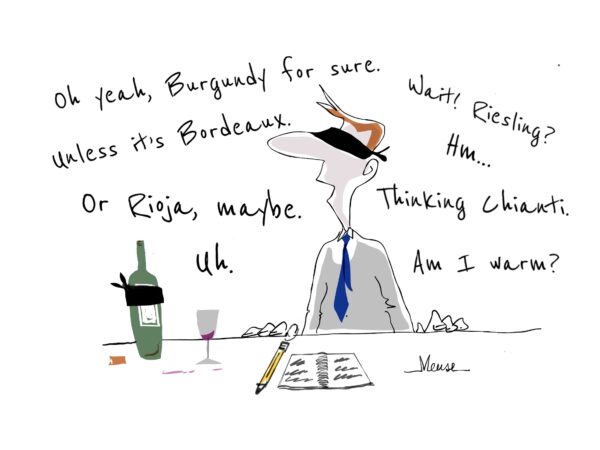 Wine has a long history, replete with fact and fancy. Over the centuries, its enthusiasts have wrapped it in a cloud of myths, tropes and what today we call memes. One of the more persistent has to do with what counts as real expertise.
Wine has a long history, replete with fact and fancy. Over the centuries, its enthusiasts have wrapped it in a cloud of myths, tropes and what today we call memes. One of the more persistent has to do with what counts as real expertise.
Who exactly is the wine connoisseur? In the popular imagination, it’s one who can invariably divine what’s in the glass, guided only by eye, nose and palate. Stories of prodigious feats of identification, descending to astonishing and frankly absurd detail are told. But how much store should we put in them, and to what degree can success at the guessing game be considered a meaningful marker of wine competence?
Clearly, the ability to identify wine in the glass demands both extensive experience and an ability to store and recall information quickly and long term. It’s easy to see that if you were, say, a winemaker with ten acres of vines spread over five distinct plots that, over time, you would get to know the character that each plot imparted to wine made from its fruit and be fluent in identifying it. The sample size is small; the time spent familiarizing yourself with it is correspondingly long. Under these circumstances, it doesn’t seem remarkable that you would soon become the world’s leading expert on the wine from your little property.
It may also be the case that in your village there are others making wine from essentially the same plots. If you were on good terms with your neighbors, you might be familiar with their wine too, and even be able to recognize how neighbor A’s wine differs from neighbor B’s and how each differs from your own. The sample size is still small, and you would have plenty of opportunity to refine your knowledge.
Next, let’s imagine you are a broker, or buyer, who travels around buying up barrels of wine from here and there with the intent of bottling and selling it under a brand name, as was the historic model in Bordeaux for generations. Under these conditions, you might well, with time, become so familiar with the output of the various townships, as to be able to readily distinguish them in the glass.
But the sample size is already getting so large that it would not be possible for you to do so with perfect accuracy, or to be infallibly certain of the vintage in every case. But, over years of doing business, you would arrive at a point where you could trust your palate to confirm with reasonable accuracy that the wine you are sampling is indeed what you are being told it is, and not something else.
Now, let’s imagine you are neither a winemaker or a buyer, but a wine writer and critic whose purview is many times larger than that provided by the foregoing examples. Thousands of subscribers look to you for advice on what to buy. You taste and report on hundreds of wines each year. Even if you have a specialty — Italian wine, let’s say — the sample size is now so enormous, and your attention necessarily so divided that the chances you would be able to correctly identify a given wine in more than general terms (varietal; region; a flyer at the vintage) are increasingly remote.
Does this make you something less than an expert at your main function, giving your readers sound advice about what wines offer the most quality and value? Certainly not.
For certifying bodies such as the Institute of Masters of Wine and Court of Master Sommeliers, blind tasting skills are important. But in each case, the emphasis is less on nailing the ID than in showing that you can reason in a capable way about why you think what you’re tasting is 1996 Chassagne-Montrachet and not some very talented California imposter. And there’s good reason for this.
The Infallible Identifier myth got its footing when the wine world was a pretty stable place, when a handful of regions were hegemonic and winemaking techniques tended to remain unchanged over long periods. That era is over.
Today, the reliable markers we used to employ to identify wine and distinguish one from another are blurring, in some cases, disappearing. For those of us old enough to remember such things, the disorientation is not unlike the experience of returning to the town you grew up in only to realize that, while you were away, they changed all the street signs.
The number, variety, diversity and geographic distribution of wine may, at some remote date, have been greater than today. But the number, variety, diversity and geographic distribution of wine actually on offer in local outlets around the world are simply unprecedented. In this context, the myth of the all-knowing, all-identifying, all-unmasking wine connoisseur is in need of a little confrontation with reality.
What’s that? You want to know if I’ve ever mistaken Burgundy for Bordeaux?
Well, yes. But not since lunch.